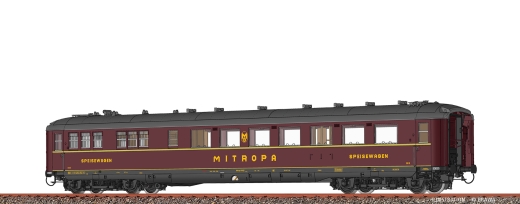Settings
Shipping country
Languages
- Products description
Products description
BRAWA 51074 - H0 dining car WR4ü-39 MITROPA
Role model information
With the class 39 express train cars, the Reichsbahn wanted to finally usher in the era of rapid transport and increase the speeds of passenger trains. In order to achieve this, the air turbulence factors that were disruptive to previous wagon designs had to be reduced. As with the type 35 cars, the type 39 increasingly relied on welding technology. However, the designers' main focus was on making the outer shell of the vehicles as smooth as possible. The areas under the frame and around the bogies in particular previously caused a lot of air resistance and so it was obvious to cover these vehicle parts with side panels. The eponymous apron was invented.
The construction, however, had further sophisticated details for the time. The entrance doors were set to the outside. A complex folding mechanism ensured that the doors opened together with the side panels despite the pivot point being deep in the car. The side window frames were also flush with the outer sheet metal. In order to create the necessary window shaft, the carriages are about 40 mm wider below the parapet.
In total, the Deutsche Reichsbahn planned to purchase over 1,000 cars in various designs. However, due to the war, only 543 series vehicles were delivered between 1939 and 1940, which were divided into 103 AB4ü-38, 310 C4ü-38, 65 ABC4ü-39 and 65 BC4ü-39. In parallel to the seating cars, Mitropa initiated a revision of the WR4ü-35 design in the wagon industry. Unlike the seated carriages, however, no completely new design was created. Rather, the entrance doors that were moved to the outside were adapted and the frame apron was added. The inwardly offset windows were retained, as was the different window height.
Due to the late delivery of the cars, operations were rather limited until the express train service was stopped due to the war. Many wagons were therefore stored in supposedly safe train stations to protect them from destruction. The fact that this was not always successful is demonstrated by various cars that were written off as war losses.
The vehicles that survived the war unscathed largely remained in West Germany. In addition to some confiscations by the occupying forces, the German Federal Railways largely prepared the cars for their newly established F-train network. The apron cars were ultimately the most modern and comfortable passenger cars on German rails at the time.
With increased deliveries of the new 26.4 m m cars from the second half of the 1950s, the DB continued the vehicles are increasingly being used in normal express trains. It would take until the mid-1970s before the last Schürzenwagen left the DB's vehicle fleet in reserve parks for military and troop transport. The wagons that remained with the Deutsche Reichsbahn Ost were transferred to the DR East in a modernization program at the beginning of the 1960s and were converted into so-called modernization wagons. In addition, some vehicles remain with the ÖBB and the SNCF.
Model details
Metal axle holder
Prototypical axle bearing covers
Brake shoes in wheel level
Individually attached steps and steps
Extra attached axle brake linkage
Multi-part brake system
Interior fittings suitable for variants
Extra attached spring packs
Complete replica of the vehicle floor
Interior lighting prepared or installed
Short coupling kinematics
Technical details
Length over buffer: 269.9 mm
Interface: soldering points
Interior: built-in
Interior lighting: built-in
Short coupling kinematics: built-in
AC wheelset replacement: no, not recommended
AC wheelset: BRAWA order no. 2187
AC grinder: BRAWA order no. 2222
Characteristics:
| Manufacturer: | BRAWA |
| Item number: | 51074 |
| number of pieces: | 1 piece |
| EAN: | 4012278510743 |
| track: | H0 |
| scale: | 1:87 |
| model series: | Passenger car Apron car / Group 39 |
| Company number: | 1165 |
| Railway company: | MITROPA |
| country: | EN |
| epoch: | III |
| Wheel set replacement: | no - not recommended |
| AC wheelset: | BRAWA order no. 2187 |
| grinder: | BRAWA order no. 2222 |
| Electricity system: | DC |
| operation mode: | DC LED |
| interface: | Solder points |
| Length over buffers: | 269.9mm |
| coupling: | NEM 362 shaft with KK kinematics |
| Interior decoration: | equipped with interior furnishings |
| Interior lighting: | built-in |
| Age recommendation: | 14 years and older |
| WEEE no.: | DE14862574 |
Information according to GPSR
Manufacturer contact details
BRAWA Artur Braun Modellspielwarenfabrik GmbH & Co. KG
Uferstraße 24-30
73630 Remshalden
Deutschland
Website: www.brawa.de
E-mail addres: info@brawa.de
Telephone: +49 (0)71 51-979 35-0
Fax: +49 (0) 71 51-746 62
For further information, please visit the homepage of this product.
This Product was added to our catalogue on 02/03/2024.
Last viewed:
















